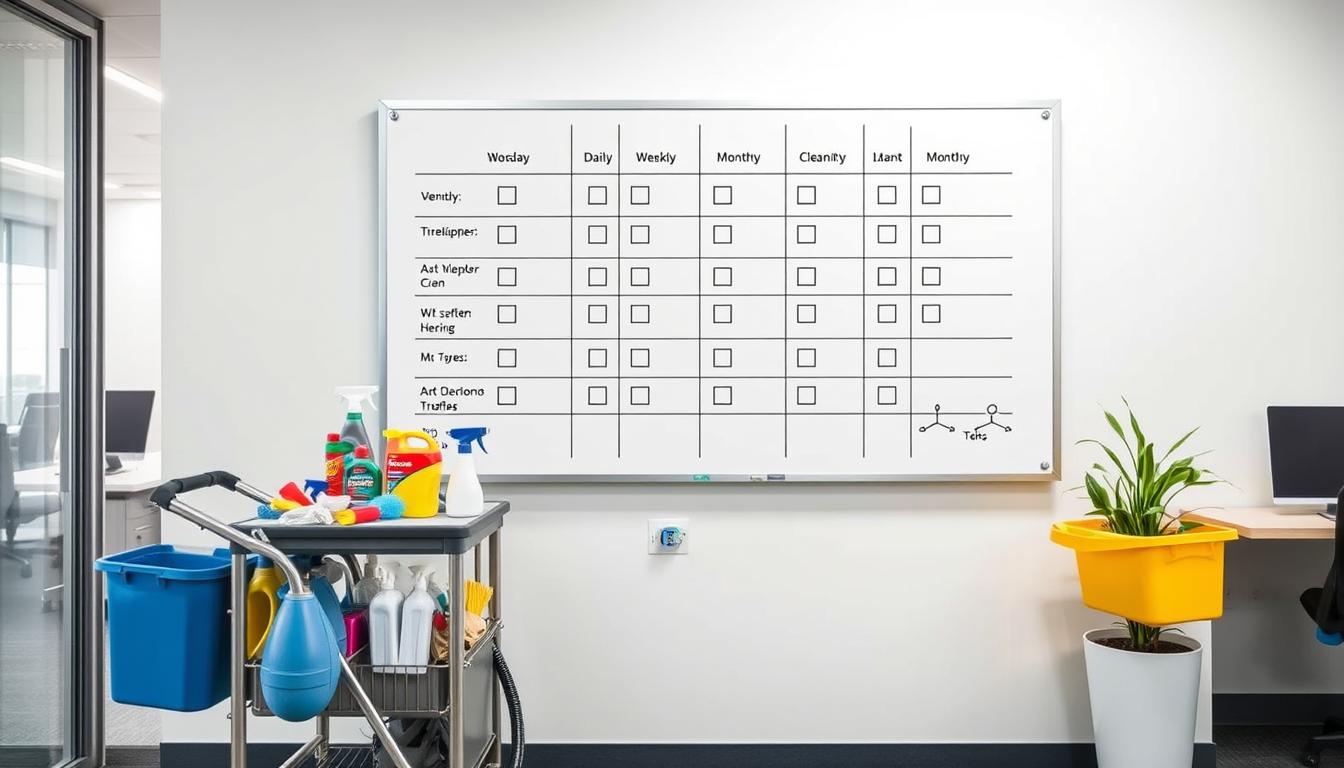In today’s fast-paced business world, keeping your space clean is key. It’s not just for employee health and safety. It also boosts your company’s image. A good cleaning schedule helps keep your work area productive and healthy.
By planning your cleaning, you save time and money. You avoid expensive repairs and replacements. Using 360 Floor Cleaning Services ensures your floors and spaces stay clean and inviting. This guide will show you how to make a cleaning schedule that fits your business needs.
Key Takeaways
- Establishing a structured commercial cleaning schedule is vital for health and safety.
- Custom cleaning plans help optimize efficiency and reduce costs.
- Regular maintenance ensures a professional appearance and enhances employee productivity.
- Assessing high-traffic areas can inform cleaning frequency.
- Professional services can boost the effectiveness of your cleaning efforts.
- Flexibility in scheduling minimizes disruption to business operations.
- Compliance with health standards is essential for creating a safe environment.
Understanding the Importance of a Cleaning Schedule
A good cleaning schedule is key for any business wanting a clean and safe place to work. Clean spaces make employees more productive and happier. This can lead to better work and more money for the company.
How often you clean is important for health and safety at work. Regular cleaning cuts down on germs and allergens. This means fewer sick days and happier employees. Studies show that clean workplaces can have up to 30% fewer sick days.
Also, a good cleaning plan makes a good impression on customers. Clean offices show clients you care about their experience. Businesses that focus on cleanliness see happier customers and keep them coming back.
Not having a cleaning plan can cause problems. Without a schedule, some areas get ignored, leading to bigger health issues. Companies must see the cost of bad cleaning, both now and in the future.
Key Components of an Effective Commercial Cleaning Schedule
An effective commercial cleaning schedule has several key parts. First, it’s important to prioritize tasks. This means figuring out which areas need more cleaning. For example, places like bathrooms and break rooms should be cleaned often.
Next, decide how often to clean. Daily tasks might include dusting and sanitizing. Less often, tasks like deep cleaning can be done weekly or monthly. This way, cleaning plans can be tailored to fit each business’s needs.
Using a cleaning checklist template helps keep cleaning staff on track. It gives them a clear list of tasks to do. This makes sure everything gets done and helps follow the cleaning schedule better.
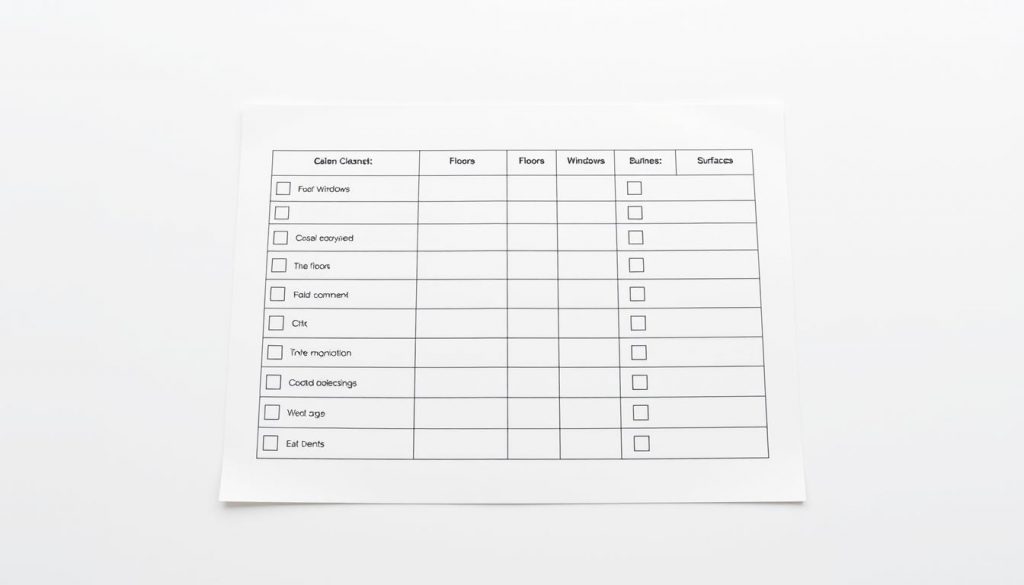
In the end, a well-organized cleaning schedule makes work healthier. It’s all about prioritizing, knowing when to clean, and keeping everyone accountable. This leads to a better work environment, where everyone can be more productive and happy.
Assessing Your Cleaning Needs
It’s key to assess your cleaning needs to keep your workspace clean and healthy. Spotting high-traffic spots helps focus cleaning efforts. This lets you see if your cleaning schedule is working well.
By figuring out what cleaning you need, you can make sure your space is great for everyone. This includes both employees and customers.
Identifying High-Traffic Areas
Places like entrances, lobbies, and common areas need extra cleaning. This keeps them clean and germ-free. By watching where people go, you can clean more often where it’s needed.
Using data on how often these spots are used helps make your cleaning schedule better. This way, you can keep your space clean and welcoming.
Evaluating Your Current Cleaning Practices
Checking how well you clean helps spot what’s working and what’s not. For example, you might find out dusting or mopping isn’t up to par. Getting feedback from staff can help make your cleaning better.
By making these changes, you can tailor your cleaning to fit your needs. For tips on dusting, check out this resource.
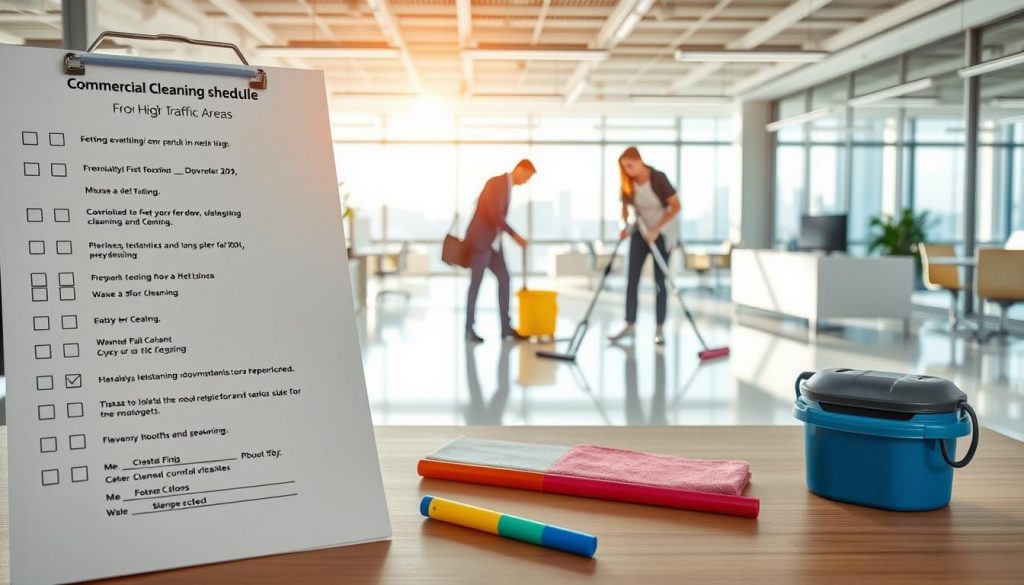
Setting Cleaning Frequency: Daily, Weekly, and Monthly Tasks
Creating a cleaning schedule is key to keeping a commercial space clean and efficient. It’s important to set tasks for daily, weekly, and monthly cleaning. This ensures that busy areas stay clean and look good.
Office Cleaning Frequency Guidelines
The cleaning schedule depends on the size and how much a place is used. A basic daily cleaning checklist commercial includes:
- Dusting surfaces and equipment
- Emptying trash bins
- Cleaning restrooms
- Wiping down high-touch areas
Weekly tasks are deeper, like:
- Vacuuming carpets
- Mopping hard floors
- Cleaning kitchen appliances
Monthly tasks are more detailed, like cleaning air vents and windows. Following these guidelines keeps your office clean.
How Often to Clean Commercial Floors
Commercial floors need special care in the cleaning schedule management. Sweep and mop daily to stop dirt. Weekly, deep clean floors by scrubbing and stripping them. Monthly, refinish floors to keep them looking good and lasting long. These steps keep your floors clean and safe.
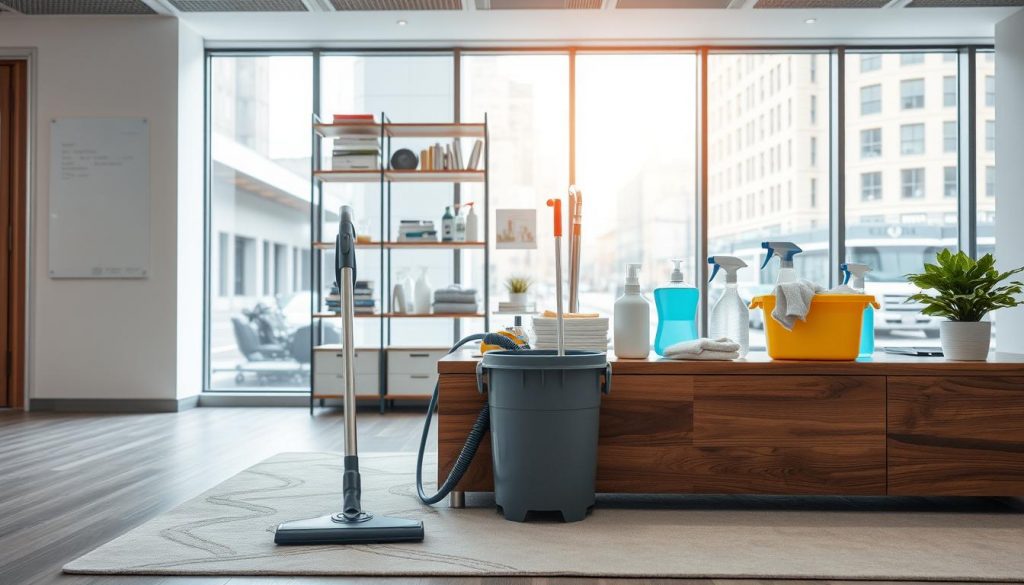
Creating a Customized Cleaning Plan
Creating a cleaning plan that fits each facility is key for a clean and efficient space. Every business is different, so it’s important to make plans that match their needs. By focusing on the right areas and cleaning them at the right time, businesses can keep their spaces clean and running smoothly.
Tailoring Your Schedule to Each Facility
When making a cleaning schedule, think about what makes your facility unique. Size, how busy it is, and what it does all play a part. Here are some steps to make a schedule that works for your place:
- Do a thorough check of your facility to find out where cleaning is most needed.
- Plan cleaning times when it won’t get in the way of your business.
- Listen to your staff to find out what they think needs extra cleaning attention.
Benefits of Customized Cleaning Plans
Custom cleaning plans bring many benefits to your business. They can make your cleaning better in several ways:
- Increased Efficiency: Plans that fit your facility mean staff can clean where it matters most, saving time and effort.
- Enhanced Hygiene: Targeted cleaning helps keep germs away, making your space healthier.
- Cost Effectiveness: Knowing exactly what you need helps avoid wasting resources, keeping costs down while keeping things clean.
Spending time on the best cleaning plans helps create a clean and healthy work environment. A well-thought-out cleaning plan is the foundation for a well-kept workspace.
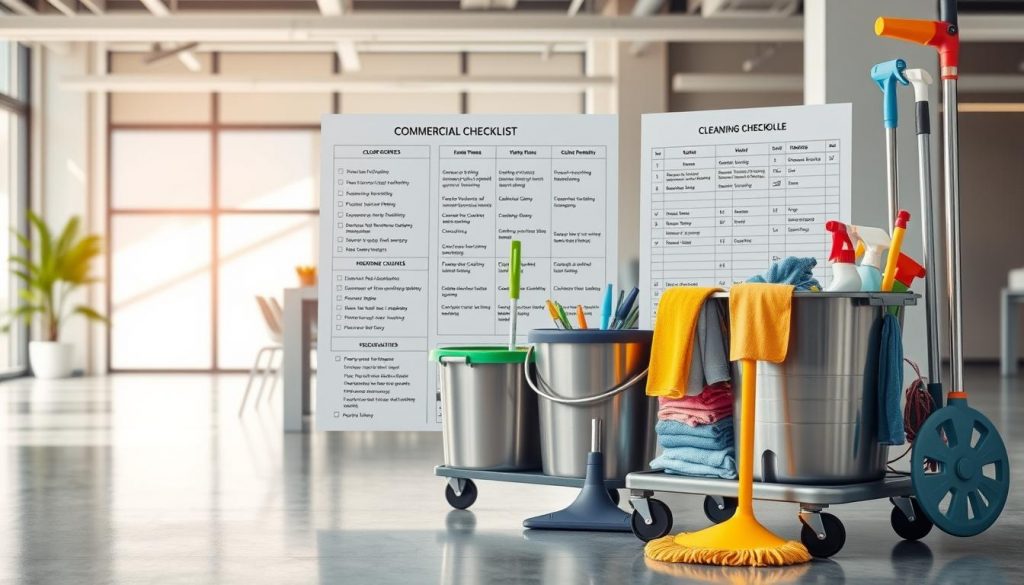
Utilizing a Commercial Cleaning Checklist Template
Using a commercial cleaning checklist template is a smart move for keeping places clean and hygienic. These templates make sure all important tasks get done, so nothing is missed. A good checklist makes cleaning easier and keeps staff on track.
When making a daily cleaning checklist for commercial spaces, think about what each area needs. For example, you might include:
- Daily dusting and sanitizing of high-touch surfaces
- Vacuuming carpets and mopping hard floors
- Emptying trash receptacles and replacing liners
- Wiping down kitchen appliances and countertops
- Cleaning restrooms, focusing on sanitation and restocking supplies
Here’s an example of what a commercial cleaning checklist might look like:
| Task | Frequency | Completed |
|---|---|---|
| Dust and sanitize surfaces | Daily | |
| Vacuum carpets | Daily | |
| Mop hard floors | Daily | |
| Clean restrooms | Daily | |
| Restock supplies | Daily |
Using a commercial cleaning checklist template helps keep cleaning organized and on track. It also helps staff remember what needs to be done. By keeping up with these tasks, places can stay clean and work better.
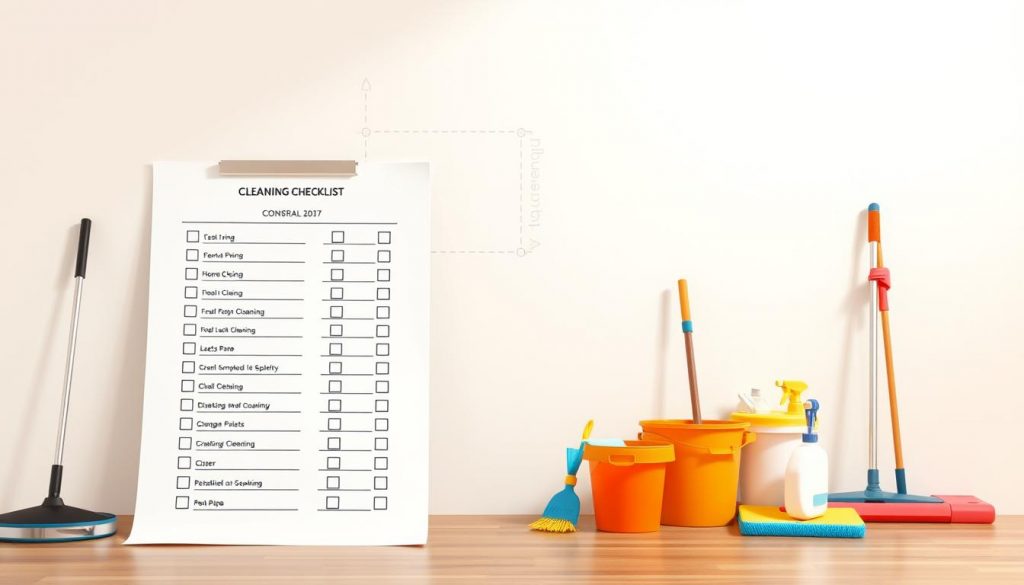
Implementing Health and Safety Standards
Health and safety standards are key for any commercial space. They keep employees safe and follow the law. Following OSHA rules helps prevent accidents and keeps the workplace healthy.
Compliance with OSHA Regulations
Every business must know and follow OSHA rules. These rules help keep the workplace safe and protect employees from dangers. Training staff regularly helps them stay up-to-date on safety.
Using the right safety gear and checking for hazards often are good ways to meet OSHA standards.
Sanitation Protocols in Commercial Spaces
Good sanitation is important for public health in commercial areas. Floors in busy places can get dirty fast. Cleaning them often is a must.
Working with professional cleaners helps keep standards high. For more on cleaning floors, check this link. A regular cleaning schedule helps keep everyone healthy and shows you care about safety.
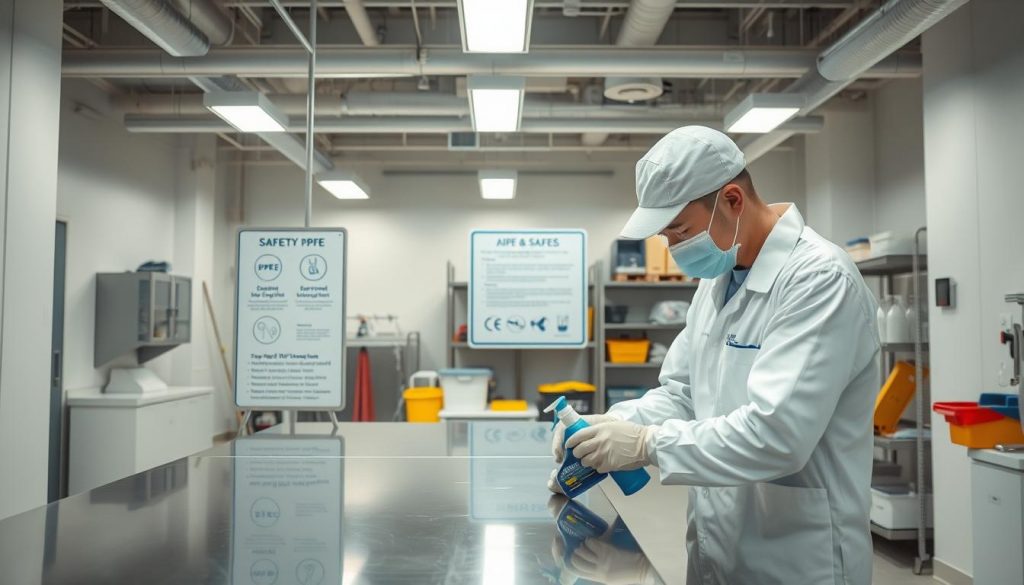
Managing Your Cleaning Schedule Effectively
Keeping your business clean and safe is key. The right tools help track tasks and assign duties clearly. With software and planning, you can create cleaning plans that fit your business.
Cleaning Schedule Management Tools
Many tools help manage cleaning schedules well. They help organize tasks, check if they’re done, and change schedules as needed. Here are some top picks:
| Tool | Features | Best For |
|---|---|---|
| CleanGuru | Automated checklists and reporting | Small to medium businesses |
| ZenMaid | Scheduling, customer management, invoicing | Cleaning services targeting residential and commercial clients |
| Jobber | Task assignment, quoting, and payment processing | Businesses needing robust client relations |
| SimplyBook.me | Online booking and management | Service-related businesses needing client scheduling |
Delegating Responsibilities
It’s important to assign tasks well to keep everyone involved. Clear roles and duties help avoid confusion and boost accountability. Here’s how to delegate tasks effectively:
- Define specific cleaning roles for each staff member.
- Provide clear instructions and necessary training.
- Utilize checklists to streamline task completion.
- Encourage regular feedback and communication among team members.
- Assess performance periodically to ensure consistency in cleaning standards.
By managing cleaning schedules and delegating tasks, you can keep your facilities clean and safe. This benefits everyone involved.
Using a Commercial Cleaning Frequency Chart
A commercial cleaning frequency chart is a key tool for cleaning schedule management. It shows how often different cleaning tasks should be done. This makes organizing cleaning routines easier.
When using a commercial cleaning frequency chart, keep these points in mind:
- Task Identification: Make a list of all cleaning tasks for your space.
- Frequency Determination: Decide how often each task should be done, based on the area’s needs.
- Consistency: Make sure the frequency of tasks matches the traffic in each area. This keeps everything clean and hygienic.
Adding a commercial cleaning frequency chart to your plan can make cleaning schedule management smoother. It helps everyone know their roles and ensures everything gets done.
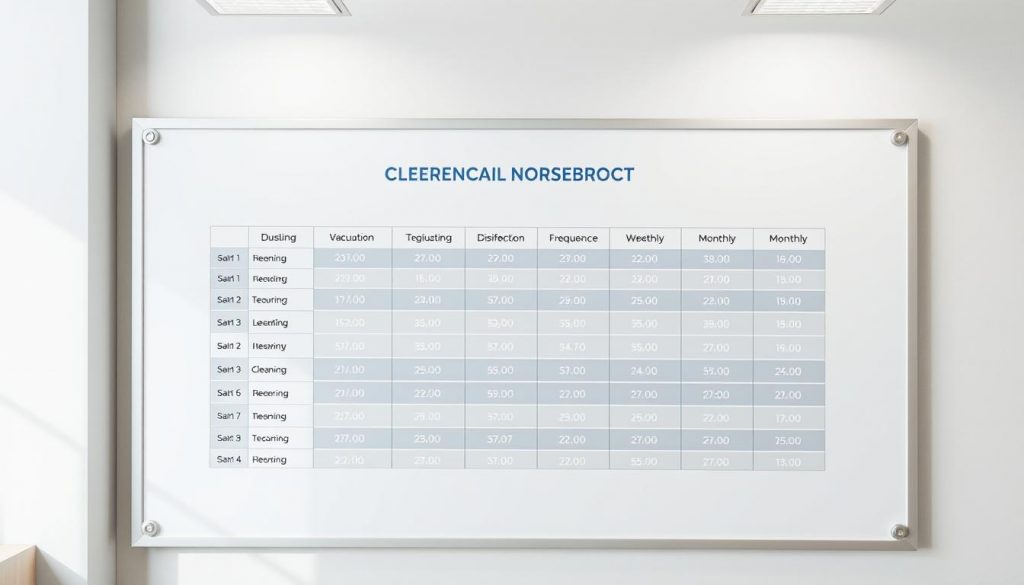
Scheduling Deep Cleaning Tasks
Creating a routine for deep cleaning is key to a clean workplace. It’s more than daily cleaning; it needs planning and scheduling. A good monthly office cleaning guide helps keep your space clean and focuses on busy areas.
Monthly Office Cleaning Guide
A monthly cleaning guide is vital for planning deep cleans. It outlines which areas need attention. This ensures your office stays clean. Important tasks include:
- Thorough carpet cleaning to remove stains and allergens
- High dusting of air vents, light fixtures, and ceiling fans
- Window washing both inside and out for clearer visibility
- Deep cleaning bathrooms to prevent the spread of germs
Using this guide helps businesses follow the best cleaning plans. This way, every part of the office is cleaned.
Cleaning Schedule for High-Traffic Areas
It’s important to have a cleaning schedule for busy areas. These spots need more cleaning than less busy ones. Focus on cleaning:
- Entrances and exits to remove debris tracked in from the outside
- Kitchens and break rooms where food and drink spills can occur
- Restrooms, which demand rigorous cleaning to uphold sanitation standards
- Hallways and stairwells, as they see high foot traffic throughout the day
This focused cleaning schedule boosts cleanliness and health in the workplace.
Best Practices for Industrial Cleaning Calendars
Creating a good industrial cleaning calendar is key for safety and efficiency. It helps organize cleaning tasks and makes sure every area is clean. Start by dividing the warehouse into sections and assign teams to each area. This way, everyone knows their job and keeps their space tidy.
Focus on high-traffic areas to avoid accidents and equipment problems. Regular cleaning in these spots is essential. Also, having a plan for waste management stops clutter and dangers from building up, making the workplace safer.
Use strong cleaners made for different floor types to keep them in good shape. Techniques like floor scrubbing and degreasing tackle tough dirt. Adjust the cleaning schedule with the seasons and how busy you are to match production needs.
Getting employees involved is important; let them help with cleaning to build a clean culture. Use warehouse floor maintenance strategies for better cleaning. Regular checks and updates of the cleaning calendar help solve problems early, keeping the facility ready for work.
Incorporating Facility Maintenance into Your Schedule
Keeping a commercial space clean and safe is more than just daily cleaning. A detailed facility maintenance schedule is key. It ensures your workplace stays safe and efficient. By mixing maintenance tasks into your cleaning routine, teams can handle both cleanliness and operations at the same time.
Begin by pinpointing important maintenance tasks like checking equipment, maintaining HVAC systems, and inspecting plumbing. Set aside specific times for these tasks in your cleaning plans. This boosts both performance and the life of your facilities. Neglecting these tasks can cause bigger problems that slow down your work.
Creating a balance between regular cleaning and ongoing maintenance is vital. Regular checks keep equipment running well, cutting down on emergency repairs and lost time. By adding these steps to your maintenance schedule, you’ll have a more efficient workspace. It will focus on both cleanliness and keeping operations running smoothly.
Exploring Professional Janitorial Services in Atlanta
Businesses in Atlanta are choosing professional janitorial services to keep their spaces clean and hygienic. Hiring experts makes managing cleaning schedules easier. This brings many benefits to different areas of business.
Benefits of Hiring Professional Services
Choosing professional janitorial services in Atlanta offers several advantages:
- Expertise and Training: Professional cleaners have the skills and knowledge to do a better job than in-house teams.
- Advanced Equipment: They use the latest cleaning tools, ensuring your space meets cleanliness standards.
- Time-Saving: Outsourcing cleaning lets your staff focus on their main tasks, not cleaning.
- Flexibility: You can adjust services to fit your needs, from daily cleaning to occasional deep cleans.
When looking at professional janitorial services in Atlanta, consider these benefits. They help decide the best way to manage your cleaning schedule.
| Benefit | Description |
|---|---|
| Expertise | Professionals have advanced cleaning techniques and strategies for different challenges. |
| Equipment | They use specialized tools that improve cleaning effectiveness and efficiency. |
| Time | This lets business employees focus on their main responsibilities. |
| Flexibility | Services can be customized to meet your specific cleaning needs. |
Creating a Cleaning Schedule by Square Footage
Creating an effective cleaning schedule starts with understanding square footage. Knowing the size of the area helps estimate time needed more accurately. A good plan ensures each area gets the right amount of cleaning based on its size.
Estimating Time and Resources Required
Creating a cleaning schedule by square footage is key for efficiency. Different areas need different times and resources based on their size. Here’s a table showing estimated cleaning times for various commercial spaces:
| Square Footage | Estimated Cleaning Time (hours) | Resource Allocation (cleaning staff) |
|---|---|---|
| 1,000 sq. ft. | 1-2 | 1 staff member |
| 2,500 sq. ft. | 2-3 | 2 staff members |
| 5,000 sq. ft. | 3-4 | 3 staff members |
| 10,000 sq. ft. | 4-6 | 4 staff members |
| 20,000 sq. ft. | 6-8 | 5 staff members |
By looking at this data and scaling it, managers can make a cleaning schedule that fits their needs. This way, they can make better staffing choices and do tasks more efficiently. It helps keep places clean and safe.
Establishing a Weekly Cleaning Routine for Your Business
A good weekly cleaning routine is key to a healthy and productive work environment. It’s important to have a structured plan to keep your space clean and efficient. Start by figuring out what your facilities need most to create a cleaning plan for warehouses.
First, list the important tasks for your weekly schedule. These might include cleaning surfaces, sweeping, mopping, and taking out the trash. Make sure to focus more on areas that get a lot of use.
It’s a good idea to assign tasks to specific staff members. This way, everyone knows their role and feels responsible. Use checklists to keep track of progress and make sure everyone stays on track.
Regularly check how well your cleaning routine is working. Listen to your team’s feedback and make changes as needed. This will help keep your workspace clean and healthy for everyone.
Developing a Retail Store Floor Cleaning Schedule
Creating a good cleaning schedule for your store’s floors is key. It keeps your store welcoming and safe for shoppers. Your schedule should fit your store’s needs, covering daily, weekly, and monthly tasks.
- Daily Tasks: Sweep and mop all floors, focusing on busy spots. Check for spills and trash to keep customers safe.
- Weekly Tasks: Deep clean certain floor areas based on foot traffic and displays. This might include buffing or polishing.
- Monthly Tasks: Do a detailed check on floor materials. See if they need repairs or refinishing to stay in top shape.
Using top commercial cleaning plans helps retailers manage their cleaning well. This ensures all areas meet health and safety rules. A well-planned cleaning schedule boosts your store’s look and makes customers happier.
Conclusion
A good commercial cleaning schedule is key for a safe and productive work space. It keeps your area clean and boosts employee happiness and work quality. By making a plan that fits your needs, you help create a healthier work place.
Using tools like cleaning charts and professional services can make cleaning easier. Companies like 360 Floor Cleaning Services offer help to make your work place spotless. With the right help, keeping your space clean is easy and effective.
Ready to improve your cleaning and make your business better? Contact 360 Floor Cleaning Services at [insert phone number]. Let’s talk about how we can change your cleaning schedule for the better.
FAQ
What should be included in a commercial floor cleaning schedule?
A good commercial floor cleaning schedule should list how often to clean. This includes daily, weekly, and monthly tasks, based on the flooring and foot traffic. It should also cover sweeping, mopping, and deep cleaning to keep floors clean.
How often should I perform office cleaning tasks?
Office cleaning depends on the space size and number of employees. High-traffic areas need daily cleaning. Deeper cleaning tasks can be weekly or monthly, part of a janitorial schedule.
What is a cleaning checklist template, and how can it help my business?
A cleaning checklist template is a detailed list of cleaning tasks. It helps keep spaces clean by ensuring tasks are done regularly. It’s great for tracking cleaning tasks and keeping a maintenance schedule.
How do I identify high-traffic areas in my facility?
To find high-traffic areas, watch where people walk and check floor wear. This helps make a cleaning schedule that focuses on these busy spots. It keeps your space clean and safe.
What are the benefits of customized cleaning plans?
Custom cleaning plans meet your business’s specific needs. They make sure cleaning fits your schedule. This approach boosts efficiency and cleanliness, key for a good cleaning strategy.
How can I implement health and safety standards in my cleaning schedule?
To follow health and safety, follow OSHA rules and create sanitation plans for your space. Regular training keeps everyone safe and compliant.
What tools are available for cleaning schedule management?
There are many tools for managing cleaning schedules. Special software helps track tasks, set reminders, and assign duties. These tools make cleaning more organized and efficient.
How can I create a cleaning schedule based on square footage?
To schedule cleaning by square footage, measure your space and decide on cleaning needs. This guides how much time and resources each task needs. It ensures all areas get the right attention.
What should a retail store floor cleaning schedule include?
A retail store cleaning schedule should include daily sweeping and mopping, weekly deep cleaning, and maintenance for stains and odors. Adjusting the schedule for customer traffic keeps the store welcoming.
